Human Resource Management Unit 3 Report: Barclays HR Functions
VerifiedAdded on 2023/01/06
|18
|4893
|21
Report
AI Summary
This report delves into the core functions of Human Resource Management (HRM), focusing on recruitment and selection processes within an organizational context. It explores the purpose of HR functions, including workforce planning, recruitment and hiring, training and development, performance management, and maintaining employee relations, with a specific focus on Barclays as a case study. The report analyzes different recruitment approaches, differentiating between internal and external methods, and discusses the strengths and weaknesses associated with each. It also outlines the essential documents required for recruitment and selection, such as job specifications, CVs, interview questions, and job offer letters. Furthermore, the report examines the role of HRM in providing talent and skills, and the pros and cons of various recruitment methods. The second part of the report briefly touches upon employee relations, the Equality Act 2010, and GDPR. The report aims to provide a comprehensive understanding of HRM practices and their significance in organizational success.
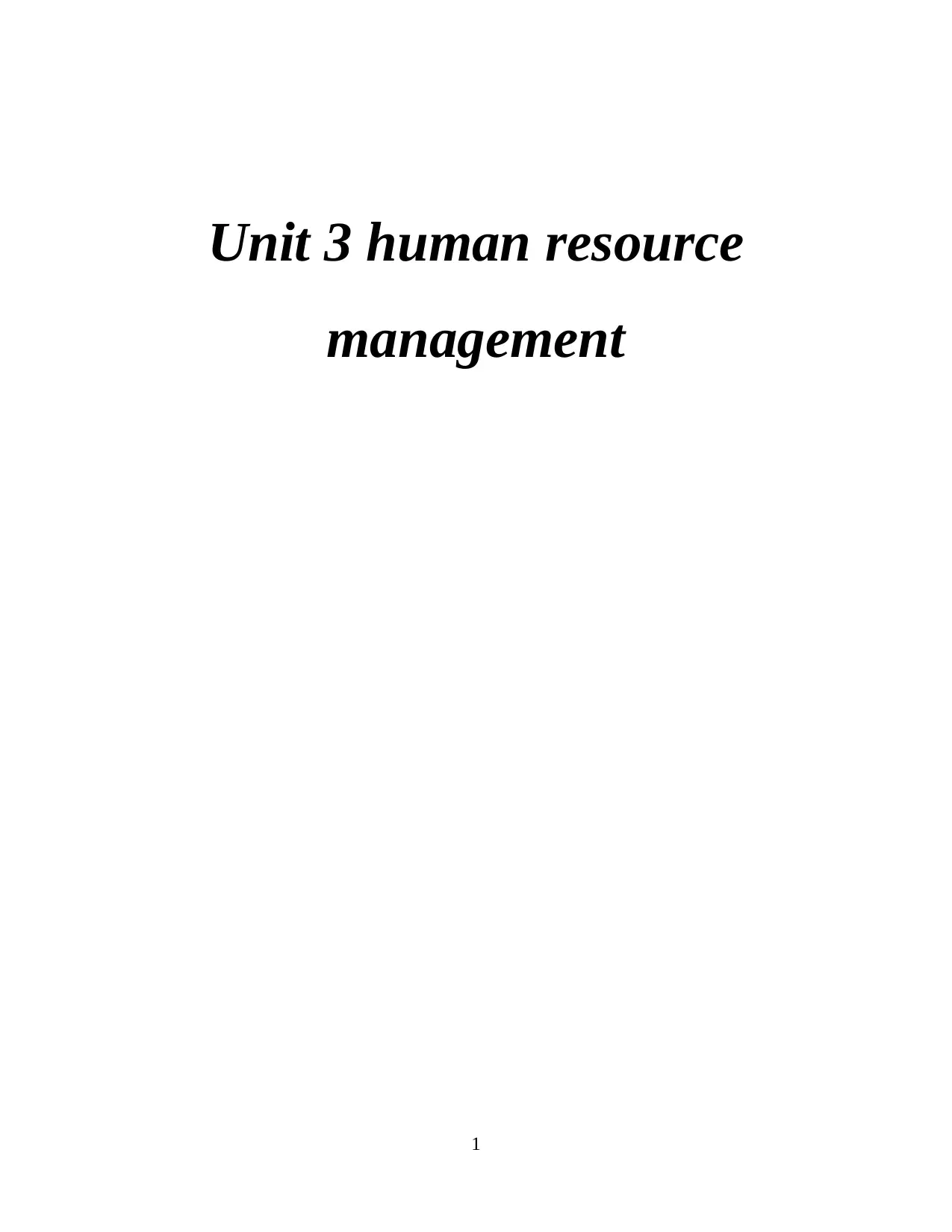
Unit 3 human resource
management
1
management
1
Paraphrase This Document
Need a fresh take? Get an instant paraphrase of this document with our AI Paraphraser

Table of Contents
PROJECT 1.....................................................................................................................................3
INTRODUCTION...........................................................................................................................3
LO 1.................................................................................................................................................3
P1 purpose of HR function and reward system...........................................................................3
P2 Strength and weakness of different approaches of recruitment..............................................4
M1 Function of HRM provide talent and skills...........................................................................6
M2 pros and cons of recruitment methods..................................................................................6
LO 4.................................................................................................................................................7
P7 document for recruitment and selection.................................................................................7
M5 rationale for application of HRM........................................................................................10
CONCLUSION..............................................................................................................................11
PROJECT 2...................................................................................................................................11
INTRODUCTION.........................................................................................................................11
Employee relation......................................................................................................................11
The Equality Act 2010...............................................................................................................12
GDPR.........................................................................................................................................13
REFERENCES..............................................................................................................................17
2
PROJECT 1.....................................................................................................................................3
INTRODUCTION...........................................................................................................................3
LO 1.................................................................................................................................................3
P1 purpose of HR function and reward system...........................................................................3
P2 Strength and weakness of different approaches of recruitment..............................................4
M1 Function of HRM provide talent and skills...........................................................................6
M2 pros and cons of recruitment methods..................................................................................6
LO 4.................................................................................................................................................7
P7 document for recruitment and selection.................................................................................7
M5 rationale for application of HRM........................................................................................10
CONCLUSION..............................................................................................................................11
PROJECT 2...................................................................................................................................11
INTRODUCTION.........................................................................................................................11
Employee relation......................................................................................................................11
The Equality Act 2010...............................................................................................................12
GDPR.........................................................................................................................................13
REFERENCES..............................................................................................................................17
2
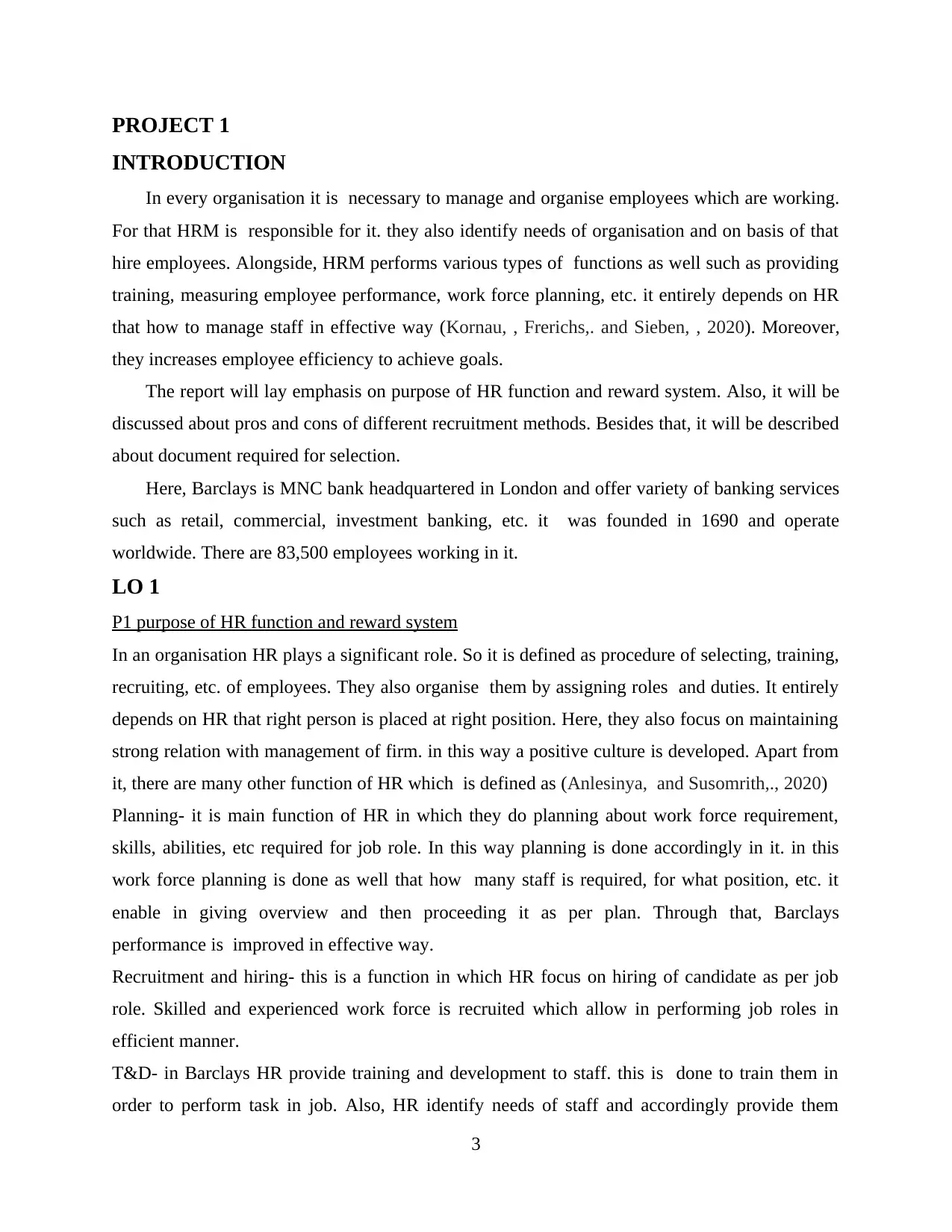
PROJECT 1
INTRODUCTION
In every organisation it is necessary to manage and organise employees which are working.
For that HRM is responsible for it. they also identify needs of organisation and on basis of that
hire employees. Alongside, HRM performs various types of functions as well such as providing
training, measuring employee performance, work force planning, etc. it entirely depends on HR
that how to manage staff in effective way (Kornau, , Frerichs,. and Sieben, , 2020). Moreover,
they increases employee efficiency to achieve goals.
The report will lay emphasis on purpose of HR function and reward system. Also, it will be
discussed about pros and cons of different recruitment methods. Besides that, it will be described
about document required for selection.
Here, Barclays is MNC bank headquartered in London and offer variety of banking services
such as retail, commercial, investment banking, etc. it was founded in 1690 and operate
worldwide. There are 83,500 employees working in it.
LO 1
P1 purpose of HR function and reward system
In an organisation HR plays a significant role. So it is defined as procedure of selecting, training,
recruiting, etc. of employees. They also organise them by assigning roles and duties. It entirely
depends on HR that right person is placed at right position. Here, they also focus on maintaining
strong relation with management of firm. in this way a positive culture is developed. Apart from
it, there are many other function of HR which is defined as (Anlesinya, and Susomrith,., 2020)
Planning- it is main function of HR in which they do planning about work force requirement,
skills, abilities, etc required for job role. In this way planning is done accordingly in it. in this
work force planning is done as well that how many staff is required, for what position, etc. it
enable in giving overview and then proceeding it as per plan. Through that, Barclays
performance is improved in effective way.
Recruitment and hiring- this is a function in which HR focus on hiring of candidate as per job
role. Skilled and experienced work force is recruited which allow in performing job roles in
efficient manner.
T&D- in Barclays HR provide training and development to staff. this is done to train them in
order to perform task in job. Also, HR identify needs of staff and accordingly provide them
3
INTRODUCTION
In every organisation it is necessary to manage and organise employees which are working.
For that HRM is responsible for it. they also identify needs of organisation and on basis of that
hire employees. Alongside, HRM performs various types of functions as well such as providing
training, measuring employee performance, work force planning, etc. it entirely depends on HR
that how to manage staff in effective way (Kornau, , Frerichs,. and Sieben, , 2020). Moreover,
they increases employee efficiency to achieve goals.
The report will lay emphasis on purpose of HR function and reward system. Also, it will be
discussed about pros and cons of different recruitment methods. Besides that, it will be described
about document required for selection.
Here, Barclays is MNC bank headquartered in London and offer variety of banking services
such as retail, commercial, investment banking, etc. it was founded in 1690 and operate
worldwide. There are 83,500 employees working in it.
LO 1
P1 purpose of HR function and reward system
In an organisation HR plays a significant role. So it is defined as procedure of selecting, training,
recruiting, etc. of employees. They also organise them by assigning roles and duties. It entirely
depends on HR that right person is placed at right position. Here, they also focus on maintaining
strong relation with management of firm. in this way a positive culture is developed. Apart from
it, there are many other function of HR which is defined as (Anlesinya, and Susomrith,., 2020)
Planning- it is main function of HR in which they do planning about work force requirement,
skills, abilities, etc required for job role. In this way planning is done accordingly in it. in this
work force planning is done as well that how many staff is required, for what position, etc. it
enable in giving overview and then proceeding it as per plan. Through that, Barclays
performance is improved in effective way.
Recruitment and hiring- this is a function in which HR focus on hiring of candidate as per job
role. Skilled and experienced work force is recruited which allow in performing job roles in
efficient manner.
T&D- in Barclays HR provide training and development to staff. this is done to train them in
order to perform task in job. Also, HR identify needs of staff and accordingly provide them
3
⊘ This is a preview!⊘
Do you want full access?
Subscribe today to unlock all pages.

Trusted by 1+ million students worldwide
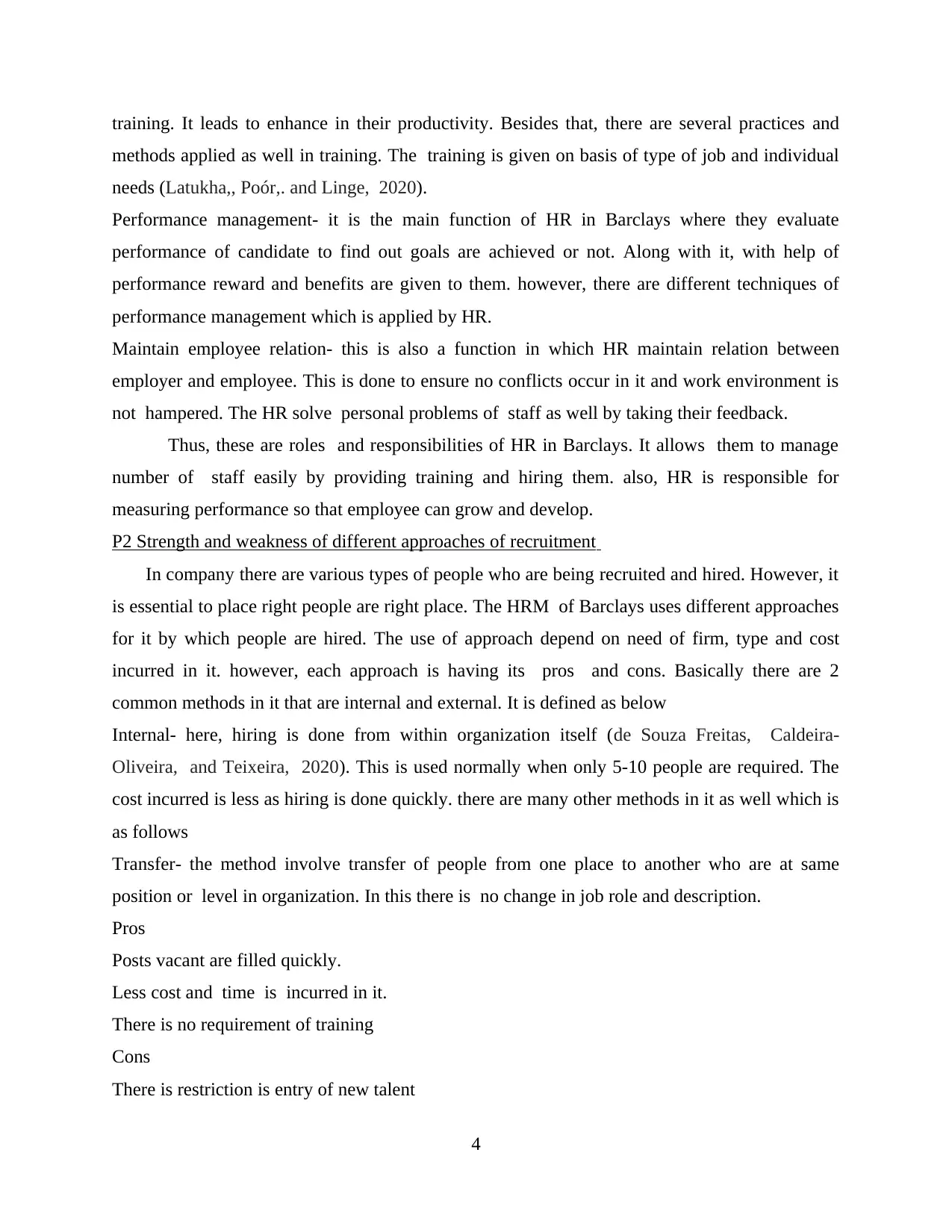
training. It leads to enhance in their productivity. Besides that, there are several practices and
methods applied as well in training. The training is given on basis of type of job and individual
needs (Latukha,, Poór,. and Linge, 2020).
Performance management- it is the main function of HR in Barclays where they evaluate
performance of candidate to find out goals are achieved or not. Along with it, with help of
performance reward and benefits are given to them. however, there are different techniques of
performance management which is applied by HR.
Maintain employee relation- this is also a function in which HR maintain relation between
employer and employee. This is done to ensure no conflicts occur in it and work environment is
not hampered. The HR solve personal problems of staff as well by taking their feedback.
Thus, these are roles and responsibilities of HR in Barclays. It allows them to manage
number of staff easily by providing training and hiring them. also, HR is responsible for
measuring performance so that employee can grow and develop.
P2 Strength and weakness of different approaches of recruitment
In company there are various types of people who are being recruited and hired. However, it
is essential to place right people are right place. The HRM of Barclays uses different approaches
for it by which people are hired. The use of approach depend on need of firm, type and cost
incurred in it. however, each approach is having its pros and cons. Basically there are 2
common methods in it that are internal and external. It is defined as below
Internal- here, hiring is done from within organization itself (de Souza Freitas, Caldeira-
Oliveira, and Teixeira, 2020). This is used normally when only 5-10 people are required. The
cost incurred is less as hiring is done quickly. there are many other methods in it as well which is
as follows
Transfer- the method involve transfer of people from one place to another who are at same
position or level in organization. In this there is no change in job role and description.
Pros
Posts vacant are filled quickly.
Less cost and time is incurred in it.
There is no requirement of training
Cons
There is restriction is entry of new talent
4
methods applied as well in training. The training is given on basis of type of job and individual
needs (Latukha,, Poór,. and Linge, 2020).
Performance management- it is the main function of HR in Barclays where they evaluate
performance of candidate to find out goals are achieved or not. Along with it, with help of
performance reward and benefits are given to them. however, there are different techniques of
performance management which is applied by HR.
Maintain employee relation- this is also a function in which HR maintain relation between
employer and employee. This is done to ensure no conflicts occur in it and work environment is
not hampered. The HR solve personal problems of staff as well by taking their feedback.
Thus, these are roles and responsibilities of HR in Barclays. It allows them to manage
number of staff easily by providing training and hiring them. also, HR is responsible for
measuring performance so that employee can grow and develop.
P2 Strength and weakness of different approaches of recruitment
In company there are various types of people who are being recruited and hired. However, it
is essential to place right people are right place. The HRM of Barclays uses different approaches
for it by which people are hired. The use of approach depend on need of firm, type and cost
incurred in it. however, each approach is having its pros and cons. Basically there are 2
common methods in it that are internal and external. It is defined as below
Internal- here, hiring is done from within organization itself (de Souza Freitas, Caldeira-
Oliveira, and Teixeira, 2020). This is used normally when only 5-10 people are required. The
cost incurred is less as hiring is done quickly. there are many other methods in it as well which is
as follows
Transfer- the method involve transfer of people from one place to another who are at same
position or level in organization. In this there is no change in job role and description.
Pros
Posts vacant are filled quickly.
Less cost and time is incurred in it.
There is no requirement of training
Cons
There is restriction is entry of new talent
4
Paraphrase This Document
Need a fresh take? Get an instant paraphrase of this document with our AI Paraphraser
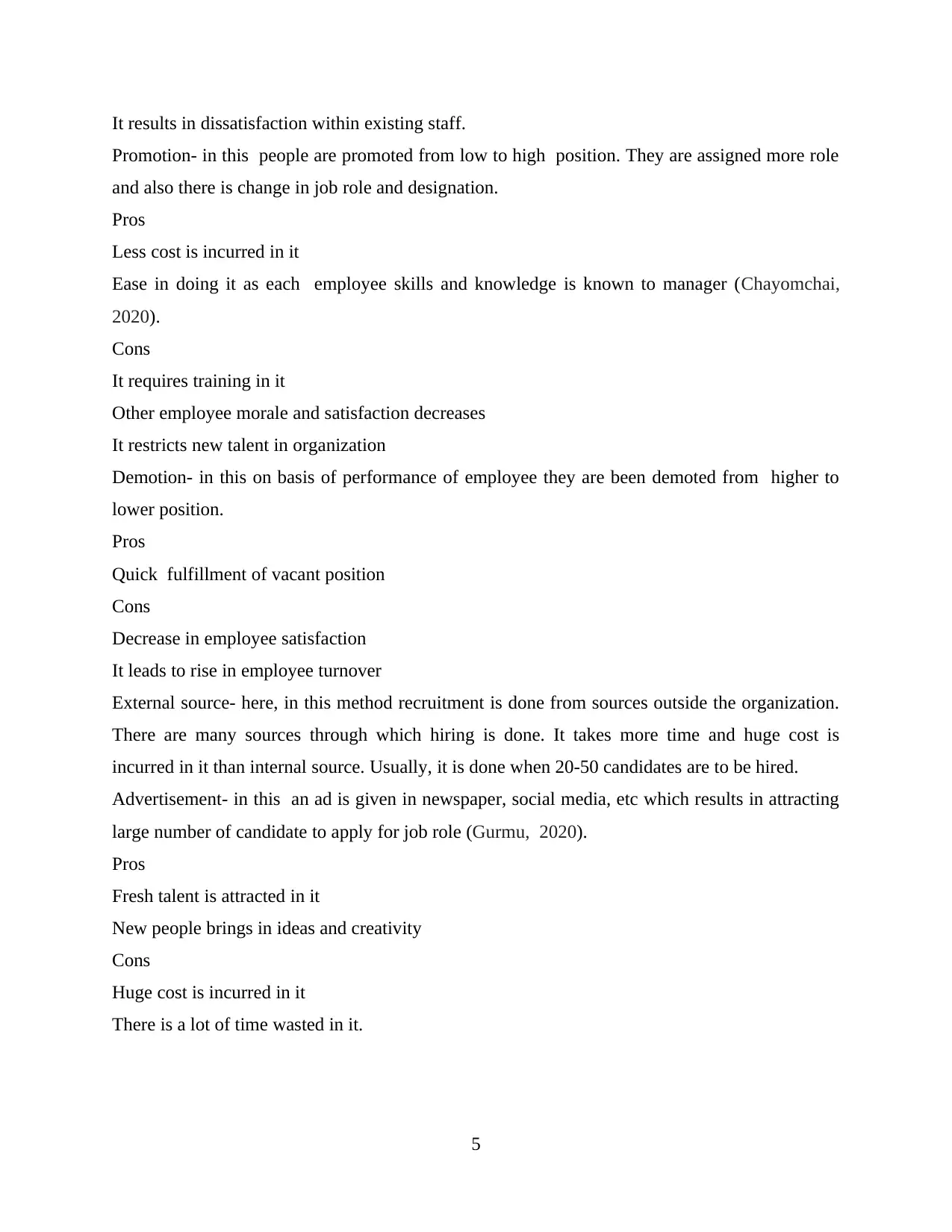
It results in dissatisfaction within existing staff.
Promotion- in this people are promoted from low to high position. They are assigned more role
and also there is change in job role and designation.
Pros
Less cost is incurred in it
Ease in doing it as each employee skills and knowledge is known to manager (Chayomchai,
2020).
Cons
It requires training in it
Other employee morale and satisfaction decreases
It restricts new talent in organization
Demotion- in this on basis of performance of employee they are been demoted from higher to
lower position.
Pros
Quick fulfillment of vacant position
Cons
Decrease in employee satisfaction
It leads to rise in employee turnover
External source- here, in this method recruitment is done from sources outside the organization.
There are many sources through which hiring is done. It takes more time and huge cost is
incurred in it than internal source. Usually, it is done when 20-50 candidates are to be hired.
Advertisement- in this an ad is given in newspaper, social media, etc which results in attracting
large number of candidate to apply for job role (Gurmu, 2020).
Pros
Fresh talent is attracted in it
New people brings in ideas and creativity
Cons
Huge cost is incurred in it
There is a lot of time wasted in it.
5
Promotion- in this people are promoted from low to high position. They are assigned more role
and also there is change in job role and designation.
Pros
Less cost is incurred in it
Ease in doing it as each employee skills and knowledge is known to manager (Chayomchai,
2020).
Cons
It requires training in it
Other employee morale and satisfaction decreases
It restricts new talent in organization
Demotion- in this on basis of performance of employee they are been demoted from higher to
lower position.
Pros
Quick fulfillment of vacant position
Cons
Decrease in employee satisfaction
It leads to rise in employee turnover
External source- here, in this method recruitment is done from sources outside the organization.
There are many sources through which hiring is done. It takes more time and huge cost is
incurred in it than internal source. Usually, it is done when 20-50 candidates are to be hired.
Advertisement- in this an ad is given in newspaper, social media, etc which results in attracting
large number of candidate to apply for job role (Gurmu, 2020).
Pros
Fresh talent is attracted in it
New people brings in ideas and creativity
Cons
Huge cost is incurred in it
There is a lot of time wasted in it.
5
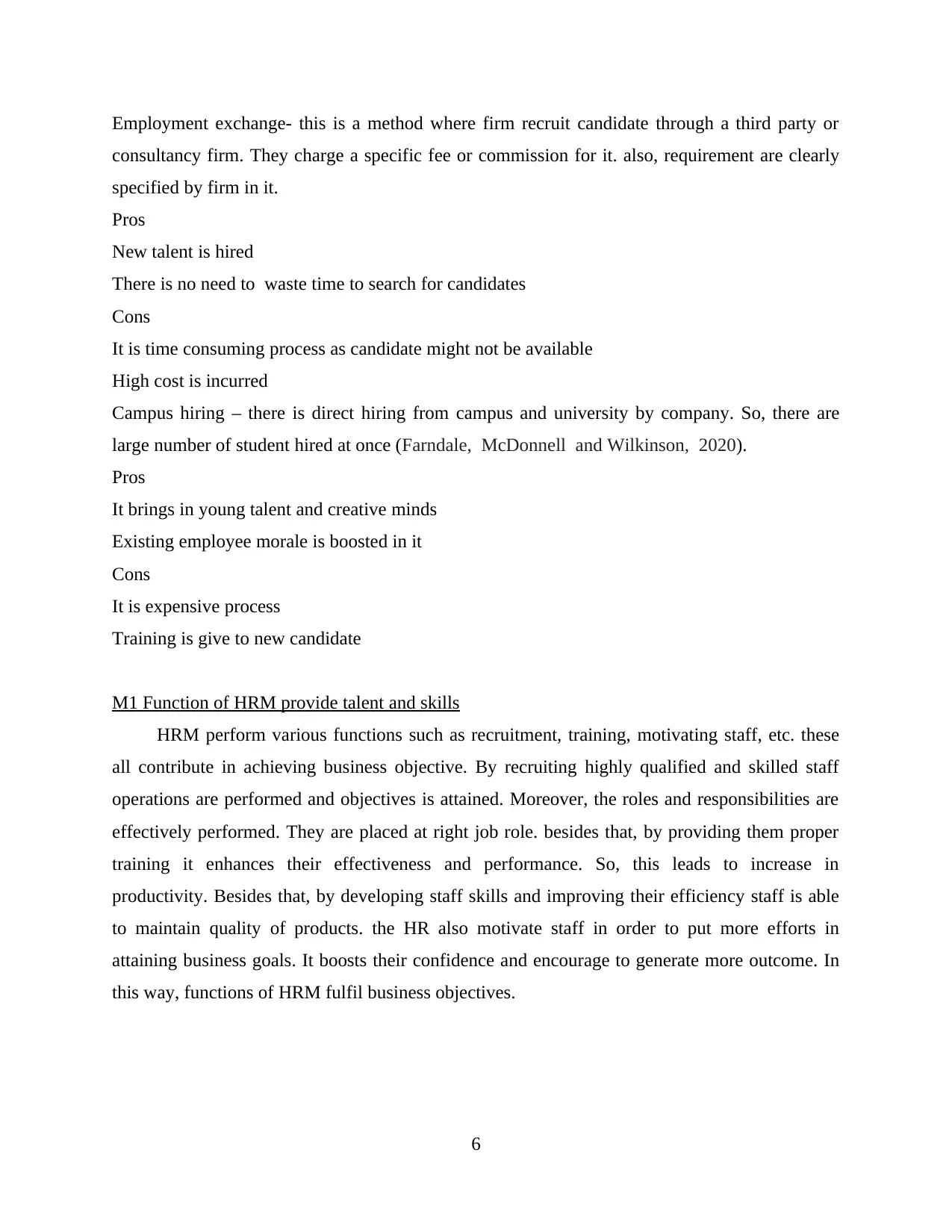
Employment exchange- this is a method where firm recruit candidate through a third party or
consultancy firm. They charge a specific fee or commission for it. also, requirement are clearly
specified by firm in it.
Pros
New talent is hired
There is no need to waste time to search for candidates
Cons
It is time consuming process as candidate might not be available
High cost is incurred
Campus hiring – there is direct hiring from campus and university by company. So, there are
large number of student hired at once (Farndale, McDonnell and Wilkinson, 2020).
Pros
It brings in young talent and creative minds
Existing employee morale is boosted in it
Cons
It is expensive process
Training is give to new candidate
M1 Function of HRM provide talent and skills
HRM perform various functions such as recruitment, training, motivating staff, etc. these
all contribute in achieving business objective. By recruiting highly qualified and skilled staff
operations are performed and objectives is attained. Moreover, the roles and responsibilities are
effectively performed. They are placed at right job role. besides that, by providing them proper
training it enhances their effectiveness and performance. So, this leads to increase in
productivity. Besides that, by developing staff skills and improving their efficiency staff is able
to maintain quality of products. the HR also motivate staff in order to put more efforts in
attaining business goals. It boosts their confidence and encourage to generate more outcome. In
this way, functions of HRM fulfil business objectives.
6
consultancy firm. They charge a specific fee or commission for it. also, requirement are clearly
specified by firm in it.
Pros
New talent is hired
There is no need to waste time to search for candidates
Cons
It is time consuming process as candidate might not be available
High cost is incurred
Campus hiring – there is direct hiring from campus and university by company. So, there are
large number of student hired at once (Farndale, McDonnell and Wilkinson, 2020).
Pros
It brings in young talent and creative minds
Existing employee morale is boosted in it
Cons
It is expensive process
Training is give to new candidate
M1 Function of HRM provide talent and skills
HRM perform various functions such as recruitment, training, motivating staff, etc. these
all contribute in achieving business objective. By recruiting highly qualified and skilled staff
operations are performed and objectives is attained. Moreover, the roles and responsibilities are
effectively performed. They are placed at right job role. besides that, by providing them proper
training it enhances their effectiveness and performance. So, this leads to increase in
productivity. Besides that, by developing staff skills and improving their efficiency staff is able
to maintain quality of products. the HR also motivate staff in order to put more efforts in
attaining business goals. It boosts their confidence and encourage to generate more outcome. In
this way, functions of HRM fulfil business objectives.
6
⊘ This is a preview!⊘
Do you want full access?
Subscribe today to unlock all pages.

Trusted by 1+ million students worldwide
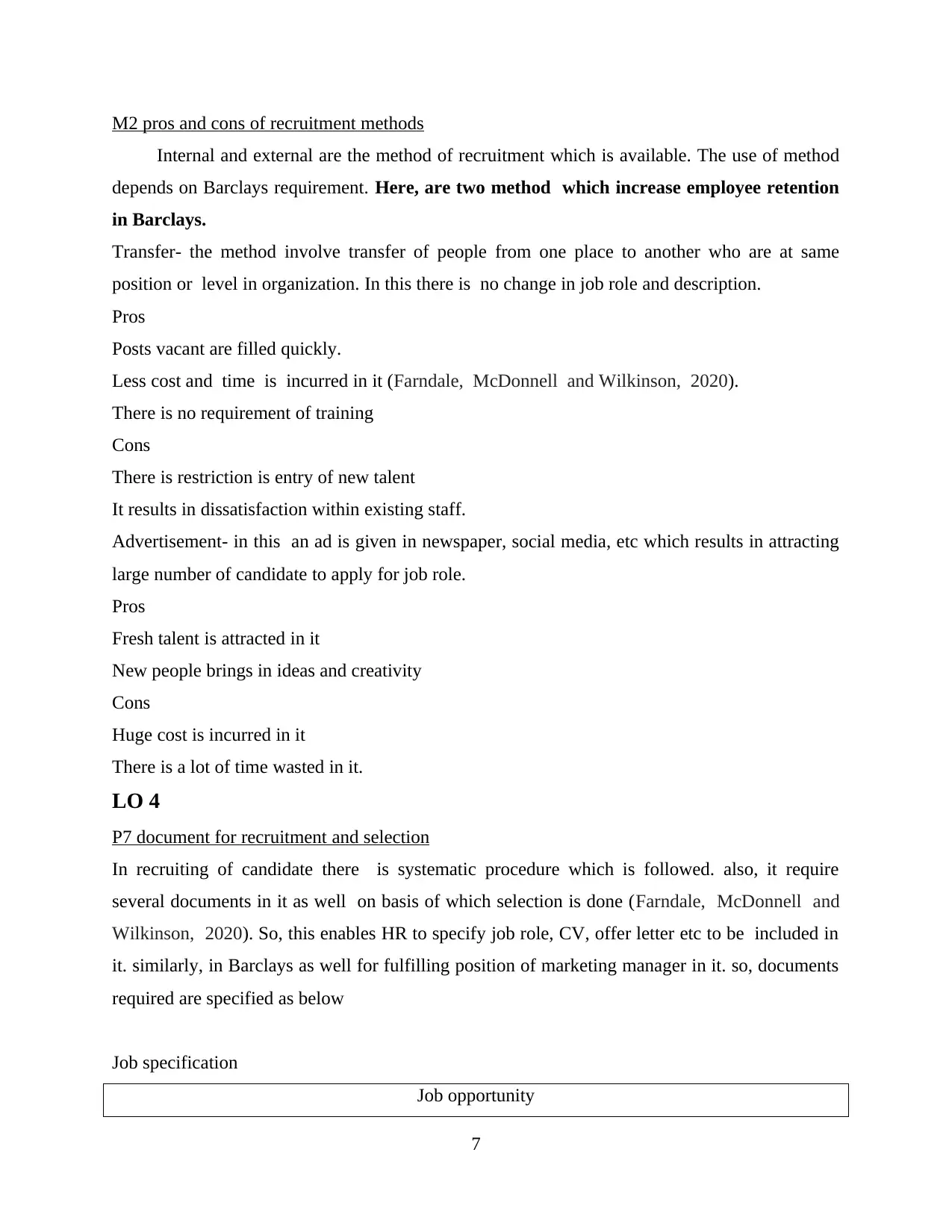
M2 pros and cons of recruitment methods
Internal and external are the method of recruitment which is available. The use of method
depends on Barclays requirement. Here, are two method which increase employee retention
in Barclays.
Transfer- the method involve transfer of people from one place to another who are at same
position or level in organization. In this there is no change in job role and description.
Pros
Posts vacant are filled quickly.
Less cost and time is incurred in it (Farndale, McDonnell and Wilkinson, 2020).
There is no requirement of training
Cons
There is restriction is entry of new talent
It results in dissatisfaction within existing staff.
Advertisement- in this an ad is given in newspaper, social media, etc which results in attracting
large number of candidate to apply for job role.
Pros
Fresh talent is attracted in it
New people brings in ideas and creativity
Cons
Huge cost is incurred in it
There is a lot of time wasted in it.
LO 4
P7 document for recruitment and selection
In recruiting of candidate there is systematic procedure which is followed. also, it require
several documents in it as well on basis of which selection is done (Farndale, McDonnell and
Wilkinson, 2020). So, this enables HR to specify job role, CV, offer letter etc to be included in
it. similarly, in Barclays as well for fulfilling position of marketing manager in it. so, documents
required are specified as below
Job specification
Job opportunity
7
Internal and external are the method of recruitment which is available. The use of method
depends on Barclays requirement. Here, are two method which increase employee retention
in Barclays.
Transfer- the method involve transfer of people from one place to another who are at same
position or level in organization. In this there is no change in job role and description.
Pros
Posts vacant are filled quickly.
Less cost and time is incurred in it (Farndale, McDonnell and Wilkinson, 2020).
There is no requirement of training
Cons
There is restriction is entry of new talent
It results in dissatisfaction within existing staff.
Advertisement- in this an ad is given in newspaper, social media, etc which results in attracting
large number of candidate to apply for job role.
Pros
Fresh talent is attracted in it
New people brings in ideas and creativity
Cons
Huge cost is incurred in it
There is a lot of time wasted in it.
LO 4
P7 document for recruitment and selection
In recruiting of candidate there is systematic procedure which is followed. also, it require
several documents in it as well on basis of which selection is done (Farndale, McDonnell and
Wilkinson, 2020). So, this enables HR to specify job role, CV, offer letter etc to be included in
it. similarly, in Barclays as well for fulfilling position of marketing manager in it. so, documents
required are specified as below
Job specification
Job opportunity
7
Paraphrase This Document
Need a fresh take? Get an instant paraphrase of this document with our AI Paraphraser
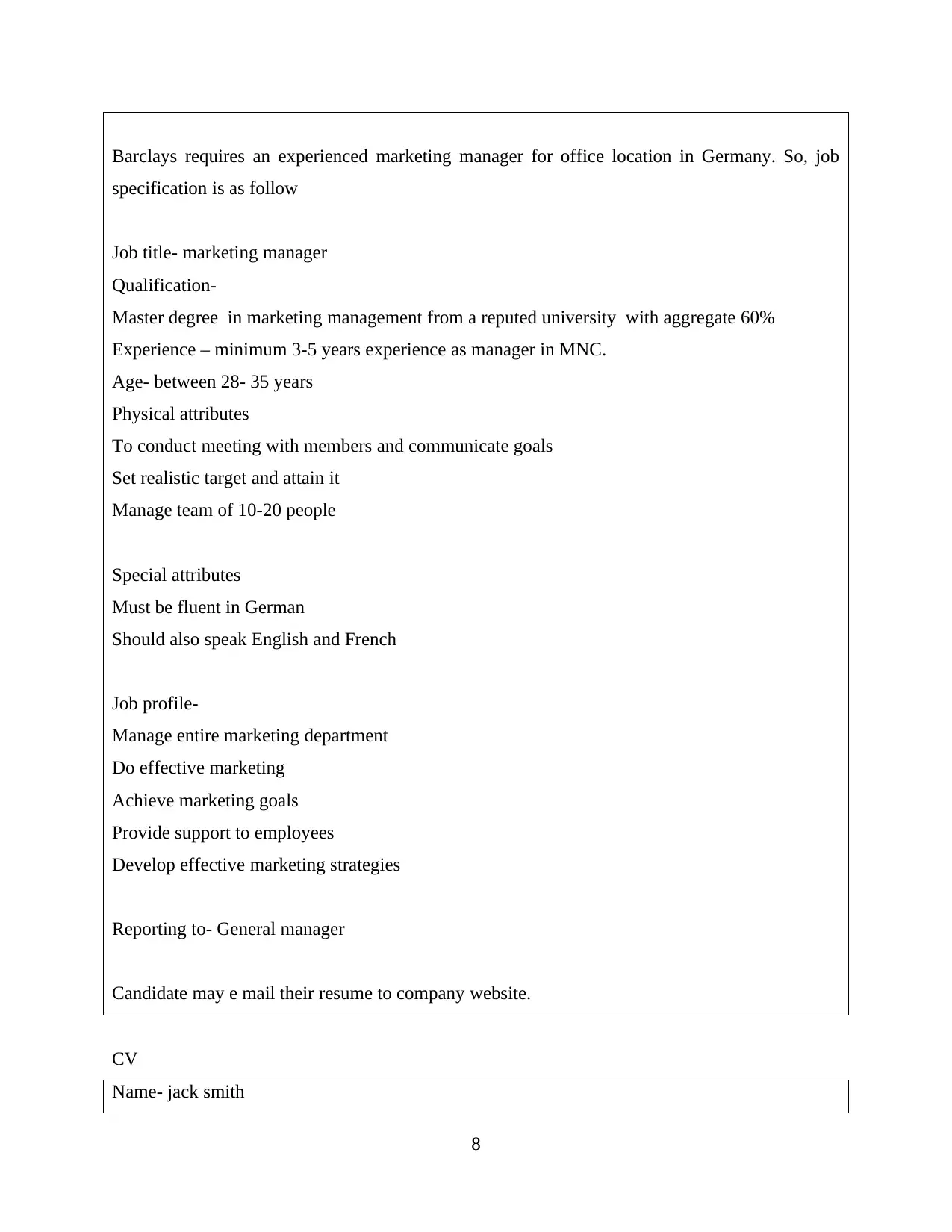
Barclays requires an experienced marketing manager for office location in Germany. So, job
specification is as follow
Job title- marketing manager
Qualification-
Master degree in marketing management from a reputed university with aggregate 60%
Experience – minimum 3-5 years experience as manager in MNC.
Age- between 28- 35 years
Physical attributes
To conduct meeting with members and communicate goals
Set realistic target and attain it
Manage team of 10-20 people
Special attributes
Must be fluent in German
Should also speak English and French
Job profile-
Manage entire marketing department
Do effective marketing
Achieve marketing goals
Provide support to employees
Develop effective marketing strategies
Reporting to- General manager
Candidate may e mail their resume to company website.
CV
Name- jack smith
8
specification is as follow
Job title- marketing manager
Qualification-
Master degree in marketing management from a reputed university with aggregate 60%
Experience – minimum 3-5 years experience as manager in MNC.
Age- between 28- 35 years
Physical attributes
To conduct meeting with members and communicate goals
Set realistic target and attain it
Manage team of 10-20 people
Special attributes
Must be fluent in German
Should also speak English and French
Job profile-
Manage entire marketing department
Do effective marketing
Achieve marketing goals
Provide support to employees
Develop effective marketing strategies
Reporting to- General manager
Candidate may e mail their resume to company website.
CV
Name- jack smith
8
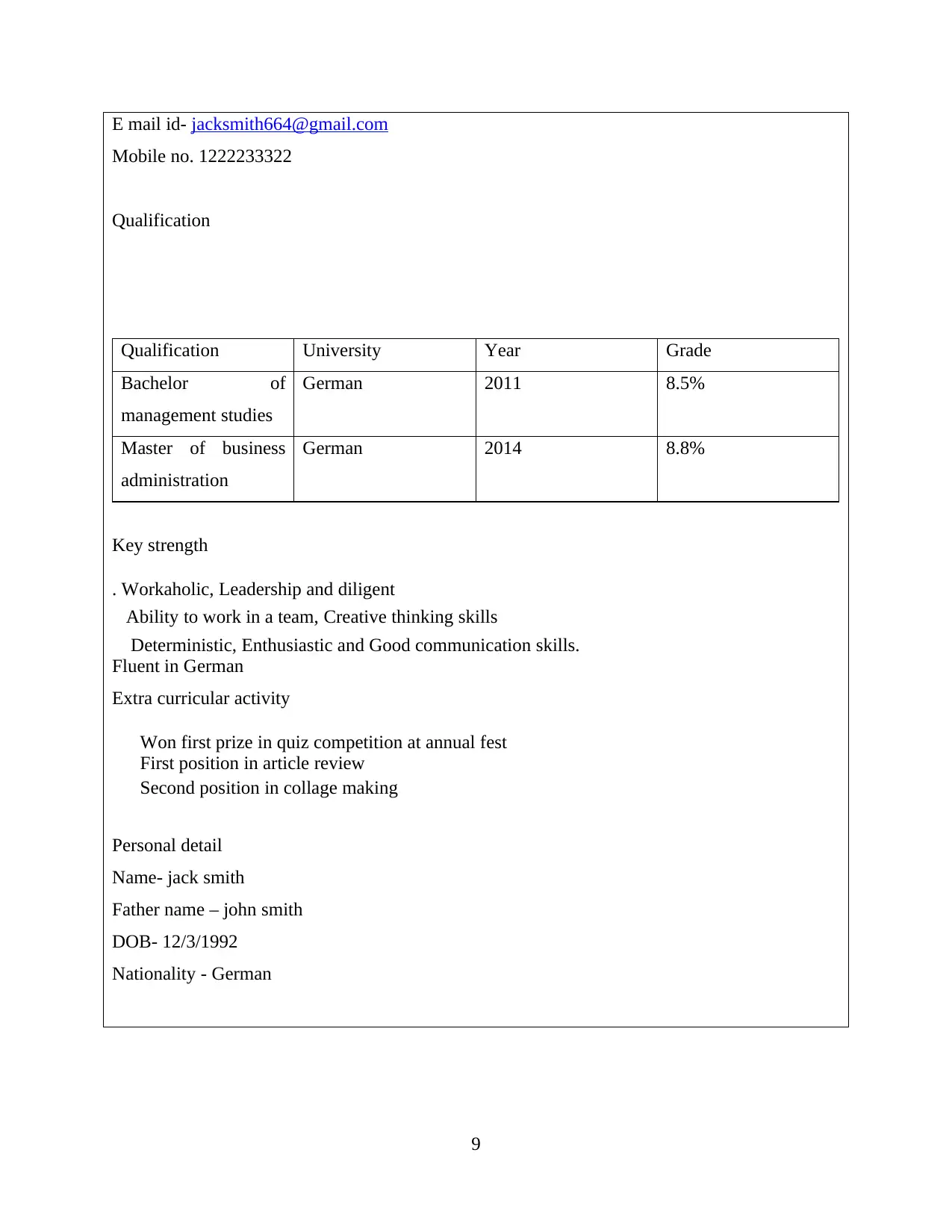
E mail id- jacksmith664@gmail.com
Mobile no. 1222233322
Qualification
Qualification University Year Grade
Bachelor of
management studies
German 2011 8.5%
Master of business
administration
German 2014 8.8%
Key strength
. Workaholic, Leadership and diligent
Ability to work in a team, Creative thinking skills
Deterministic, Enthusiastic and Good communication skills.
Fluent in German
Extra curricular activity
Won first prize in quiz competition at annual fest
First position in article review
Second position in collage making
Personal detail
Name- jack smith
Father name – john smith
DOB- 12/3/1992
Nationality - German
9
Mobile no. 1222233322
Qualification
Qualification University Year Grade
Bachelor of
management studies
German 2011 8.5%
Master of business
administration
German 2014 8.8%
Key strength
. Workaholic, Leadership and diligent
Ability to work in a team, Creative thinking skills
Deterministic, Enthusiastic and Good communication skills.
Fluent in German
Extra curricular activity
Won first prize in quiz competition at annual fest
First position in article review
Second position in collage making
Personal detail
Name- jack smith
Father name – john smith
DOB- 12/3/1992
Nationality - German
9
⊘ This is a preview!⊘
Do you want full access?
Subscribe today to unlock all pages.

Trusted by 1+ million students worldwide
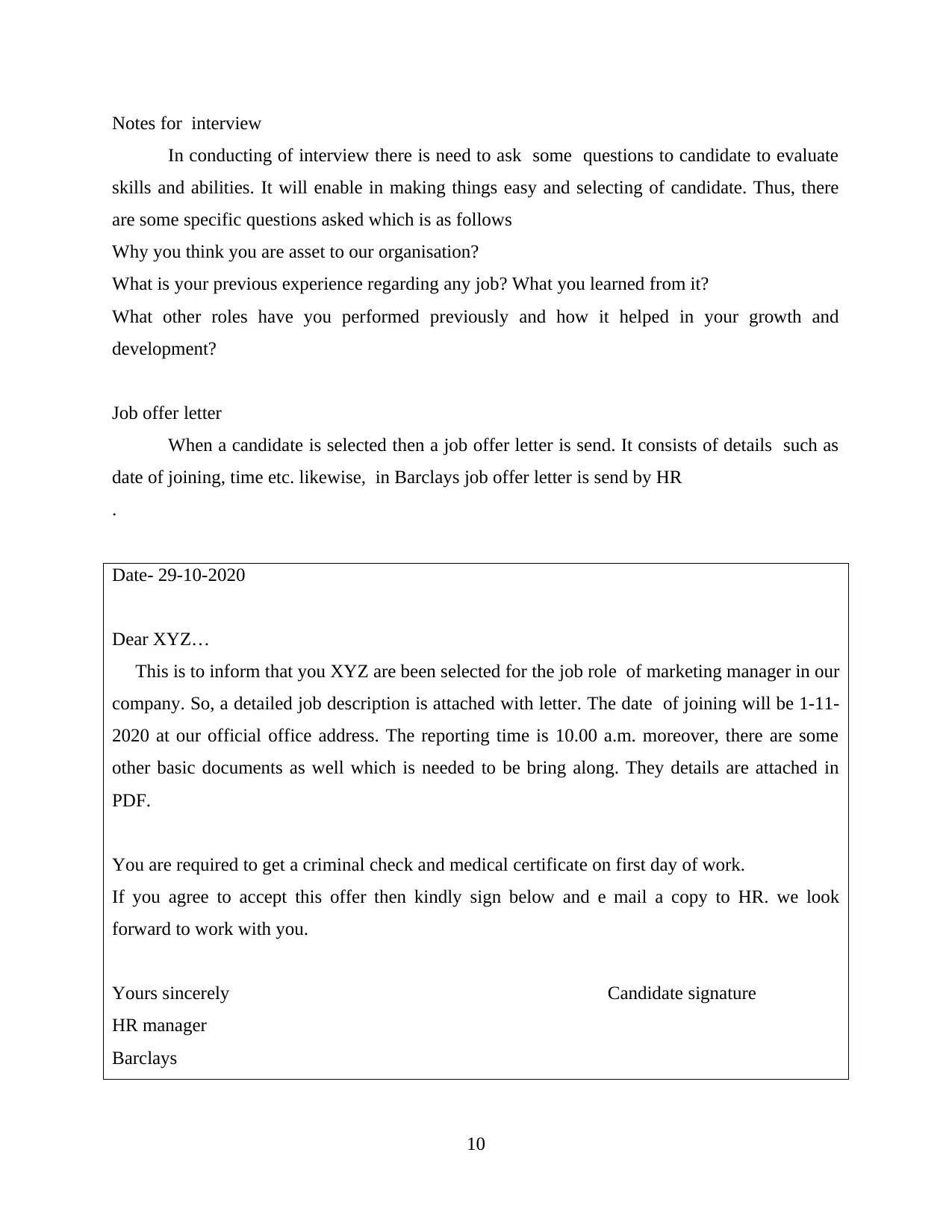
Notes for interview
In conducting of interview there is need to ask some questions to candidate to evaluate
skills and abilities. It will enable in making things easy and selecting of candidate. Thus, there
are some specific questions asked which is as follows
Why you think you are asset to our organisation?
What is your previous experience regarding any job? What you learned from it?
What other roles have you performed previously and how it helped in your growth and
development?
Job offer letter
When a candidate is selected then a job offer letter is send. It consists of details such as
date of joining, time etc. likewise, in Barclays job offer letter is send by HR
.
Date- 29-10-2020
Dear XYZ…
This is to inform that you XYZ are been selected for the job role of marketing manager in our
company. So, a detailed job description is attached with letter. The date of joining will be 1-11-
2020 at our official office address. The reporting time is 10.00 a.m. moreover, there are some
other basic documents as well which is needed to be bring along. They details are attached in
PDF.
You are required to get a criminal check and medical certificate on first day of work.
If you agree to accept this offer then kindly sign below and e mail a copy to HR. we look
forward to work with you.
Yours sincerely Candidate signature
HR manager
Barclays
10
In conducting of interview there is need to ask some questions to candidate to evaluate
skills and abilities. It will enable in making things easy and selecting of candidate. Thus, there
are some specific questions asked which is as follows
Why you think you are asset to our organisation?
What is your previous experience regarding any job? What you learned from it?
What other roles have you performed previously and how it helped in your growth and
development?
Job offer letter
When a candidate is selected then a job offer letter is send. It consists of details such as
date of joining, time etc. likewise, in Barclays job offer letter is send by HR
.
Date- 29-10-2020
Dear XYZ…
This is to inform that you XYZ are been selected for the job role of marketing manager in our
company. So, a detailed job description is attached with letter. The date of joining will be 1-11-
2020 at our official office address. The reporting time is 10.00 a.m. moreover, there are some
other basic documents as well which is needed to be bring along. They details are attached in
PDF.
You are required to get a criminal check and medical certificate on first day of work.
If you agree to accept this offer then kindly sign below and e mail a copy to HR. we look
forward to work with you.
Yours sincerely Candidate signature
HR manager
Barclays
10
Paraphrase This Document
Need a fresh take? Get an instant paraphrase of this document with our AI Paraphraser
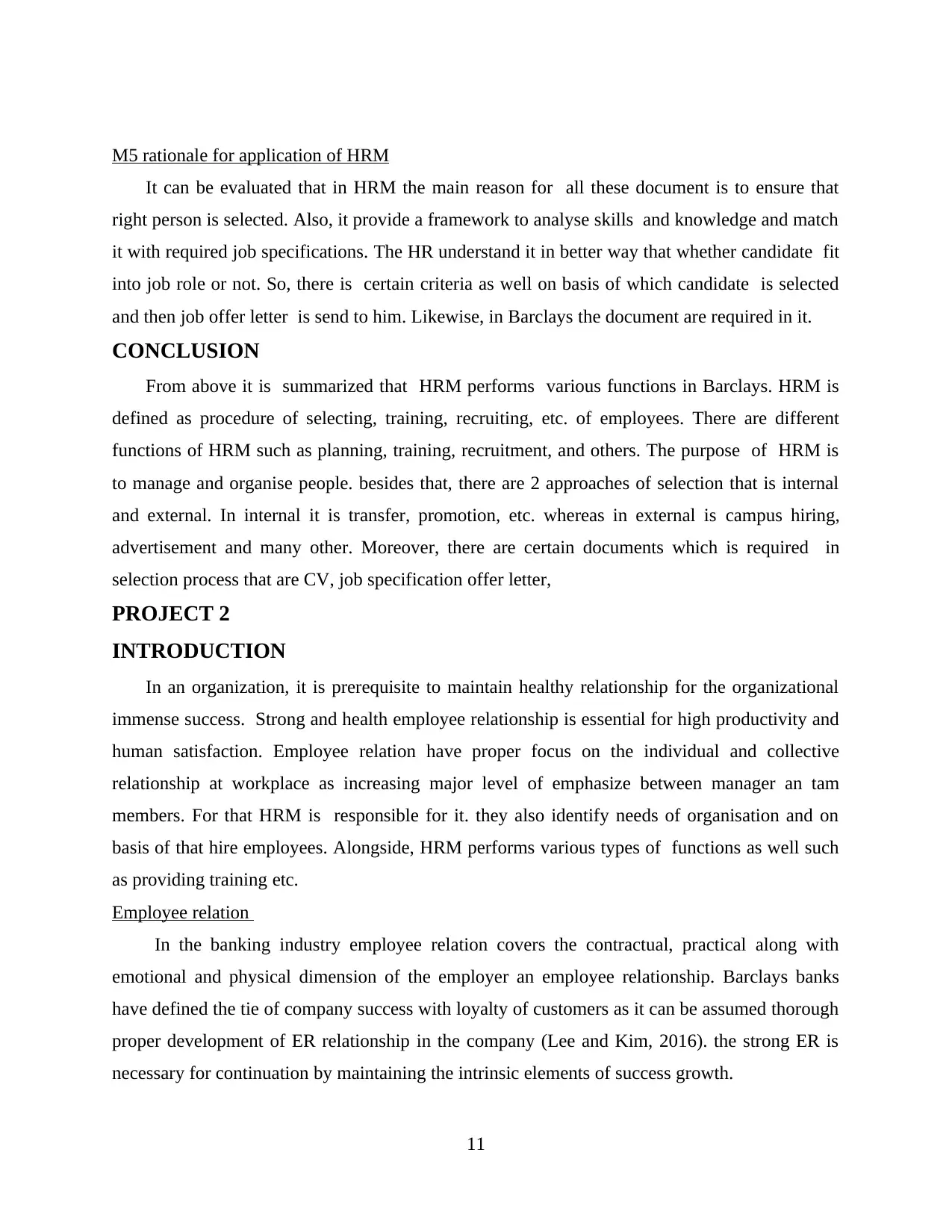
M5 rationale for application of HRM
It can be evaluated that in HRM the main reason for all these document is to ensure that
right person is selected. Also, it provide a framework to analyse skills and knowledge and match
it with required job specifications. The HR understand it in better way that whether candidate fit
into job role or not. So, there is certain criteria as well on basis of which candidate is selected
and then job offer letter is send to him. Likewise, in Barclays the document are required in it.
CONCLUSION
From above it is summarized that HRM performs various functions in Barclays. HRM is
defined as procedure of selecting, training, recruiting, etc. of employees. There are different
functions of HRM such as planning, training, recruitment, and others. The purpose of HRM is
to manage and organise people. besides that, there are 2 approaches of selection that is internal
and external. In internal it is transfer, promotion, etc. whereas in external is campus hiring,
advertisement and many other. Moreover, there are certain documents which is required in
selection process that are CV, job specification offer letter,
PROJECT 2
INTRODUCTION
In an organization, it is prerequisite to maintain healthy relationship for the organizational
immense success. Strong and health employee relationship is essential for high productivity and
human satisfaction. Employee relation have proper focus on the individual and collective
relationship at workplace as increasing major level of emphasize between manager an tam
members. For that HRM is responsible for it. they also identify needs of organisation and on
basis of that hire employees. Alongside, HRM performs various types of functions as well such
as providing training etc.
Employee relation
In the banking industry employee relation covers the contractual, practical along with
emotional and physical dimension of the employer an employee relationship. Barclays banks
have defined the tie of company success with loyalty of customers as it can be assumed thorough
proper development of ER relationship in the company (Lee and Kim, 2016). the strong ER is
necessary for continuation by maintaining the intrinsic elements of success growth.
11
It can be evaluated that in HRM the main reason for all these document is to ensure that
right person is selected. Also, it provide a framework to analyse skills and knowledge and match
it with required job specifications. The HR understand it in better way that whether candidate fit
into job role or not. So, there is certain criteria as well on basis of which candidate is selected
and then job offer letter is send to him. Likewise, in Barclays the document are required in it.
CONCLUSION
From above it is summarized that HRM performs various functions in Barclays. HRM is
defined as procedure of selecting, training, recruiting, etc. of employees. There are different
functions of HRM such as planning, training, recruitment, and others. The purpose of HRM is
to manage and organise people. besides that, there are 2 approaches of selection that is internal
and external. In internal it is transfer, promotion, etc. whereas in external is campus hiring,
advertisement and many other. Moreover, there are certain documents which is required in
selection process that are CV, job specification offer letter,
PROJECT 2
INTRODUCTION
In an organization, it is prerequisite to maintain healthy relationship for the organizational
immense success. Strong and health employee relationship is essential for high productivity and
human satisfaction. Employee relation have proper focus on the individual and collective
relationship at workplace as increasing major level of emphasize between manager an tam
members. For that HRM is responsible for it. they also identify needs of organisation and on
basis of that hire employees. Alongside, HRM performs various types of functions as well such
as providing training etc.
Employee relation
In the banking industry employee relation covers the contractual, practical along with
emotional and physical dimension of the employer an employee relationship. Barclays banks
have defined the tie of company success with loyalty of customers as it can be assumed thorough
proper development of ER relationship in the company (Lee and Kim, 2016). the strong ER is
necessary for continuation by maintaining the intrinsic elements of success growth.
11
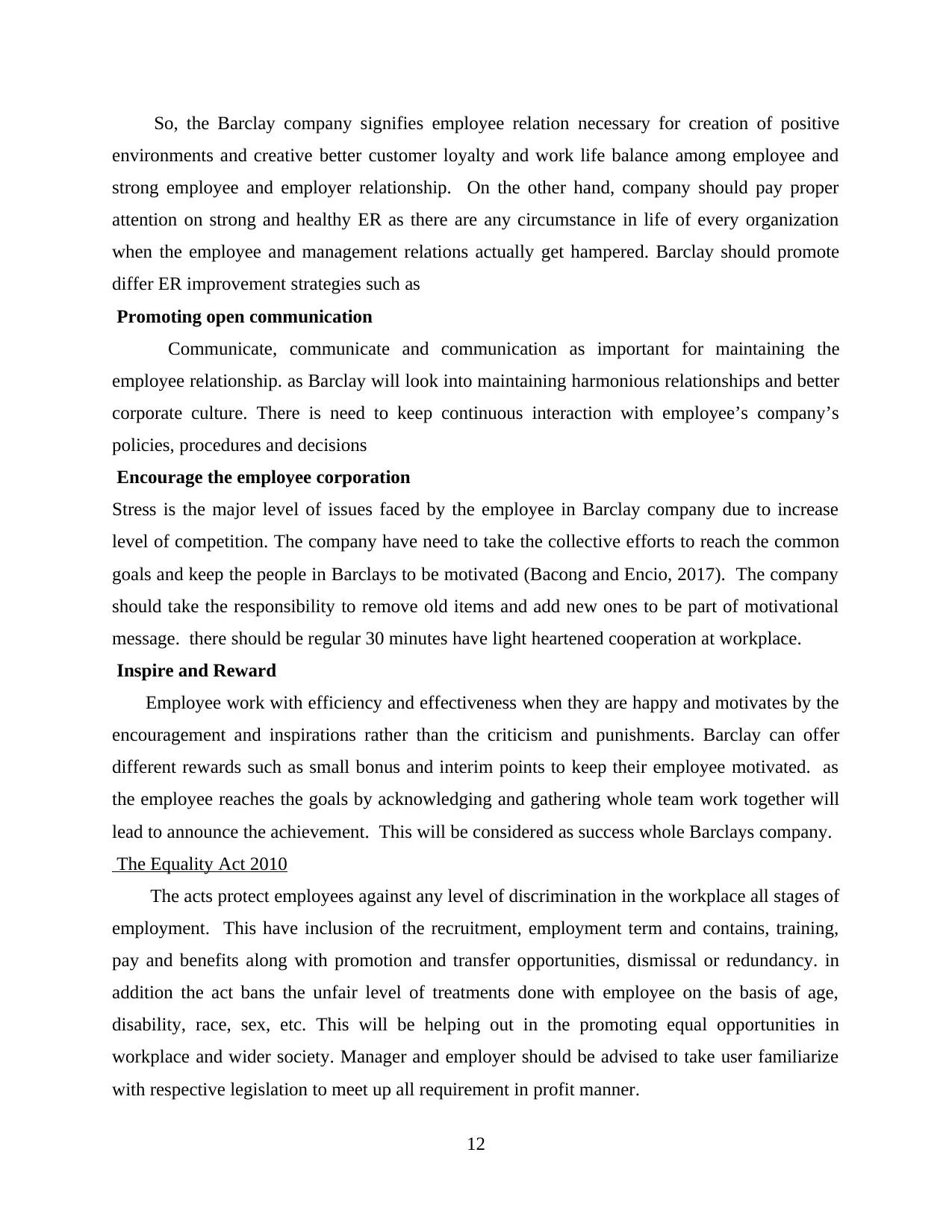
So, the Barclay company signifies employee relation necessary for creation of positive
environments and creative better customer loyalty and work life balance among employee and
strong employee and employer relationship. On the other hand, company should pay proper
attention on strong and healthy ER as there are any circumstance in life of every organization
when the employee and management relations actually get hampered. Barclay should promote
differ ER improvement strategies such as
Promoting open communication
Communicate, communicate and communication as important for maintaining the
employee relationship. as Barclay will look into maintaining harmonious relationships and better
corporate culture. There is need to keep continuous interaction with employee’s company’s
policies, procedures and decisions
Encourage the employee corporation
Stress is the major level of issues faced by the employee in Barclay company due to increase
level of competition. The company have need to take the collective efforts to reach the common
goals and keep the people in Barclays to be motivated (Bacong and Encio, 2017). The company
should take the responsibility to remove old items and add new ones to be part of motivational
message. there should be regular 30 minutes have light heartened cooperation at workplace.
Inspire and Reward
Employee work with efficiency and effectiveness when they are happy and motivates by the
encouragement and inspirations rather than the criticism and punishments. Barclay can offer
different rewards such as small bonus and interim points to keep their employee motivated. as
the employee reaches the goals by acknowledging and gathering whole team work together will
lead to announce the achievement. This will be considered as success whole Barclays company.
The Equality Act 2010
The acts protect employees against any level of discrimination in the workplace all stages of
employment. This have inclusion of the recruitment, employment term and contains, training,
pay and benefits along with promotion and transfer opportunities, dismissal or redundancy. in
addition the act bans the unfair level of treatments done with employee on the basis of age,
disability, race, sex, etc. This will be helping out in the promoting equal opportunities in
workplace and wider society. Manager and employer should be advised to take user familiarize
with respective legislation to meet up all requirement in profit manner.
12
environments and creative better customer loyalty and work life balance among employee and
strong employee and employer relationship. On the other hand, company should pay proper
attention on strong and healthy ER as there are any circumstance in life of every organization
when the employee and management relations actually get hampered. Barclay should promote
differ ER improvement strategies such as
Promoting open communication
Communicate, communicate and communication as important for maintaining the
employee relationship. as Barclay will look into maintaining harmonious relationships and better
corporate culture. There is need to keep continuous interaction with employee’s company’s
policies, procedures and decisions
Encourage the employee corporation
Stress is the major level of issues faced by the employee in Barclay company due to increase
level of competition. The company have need to take the collective efforts to reach the common
goals and keep the people in Barclays to be motivated (Bacong and Encio, 2017). The company
should take the responsibility to remove old items and add new ones to be part of motivational
message. there should be regular 30 minutes have light heartened cooperation at workplace.
Inspire and Reward
Employee work with efficiency and effectiveness when they are happy and motivates by the
encouragement and inspirations rather than the criticism and punishments. Barclay can offer
different rewards such as small bonus and interim points to keep their employee motivated. as
the employee reaches the goals by acknowledging and gathering whole team work together will
lead to announce the achievement. This will be considered as success whole Barclays company.
The Equality Act 2010
The acts protect employees against any level of discrimination in the workplace all stages of
employment. This have inclusion of the recruitment, employment term and contains, training,
pay and benefits along with promotion and transfer opportunities, dismissal or redundancy. in
addition the act bans the unfair level of treatments done with employee on the basis of age,
disability, race, sex, etc. This will be helping out in the promoting equal opportunities in
workplace and wider society. Manager and employer should be advised to take user familiarize
with respective legislation to meet up all requirement in profit manner.
12
⊘ This is a preview!⊘
Do you want full access?
Subscribe today to unlock all pages.

Trusted by 1+ million students worldwide
1 out of 18
Related Documents
Your All-in-One AI-Powered Toolkit for Academic Success.
+13062052269
info@desklib.com
Available 24*7 on WhatsApp / Email
![[object Object]](/_next/static/media/star-bottom.7253800d.svg)
Unlock your academic potential
Copyright © 2020–2025 A2Z Services. All Rights Reserved. Developed and managed by ZUCOL.





